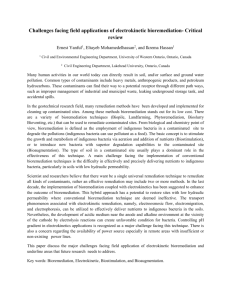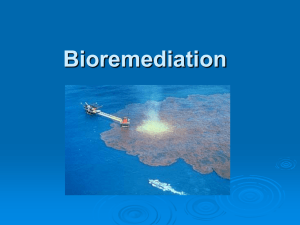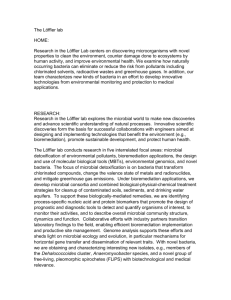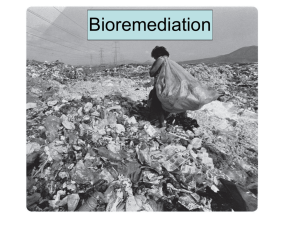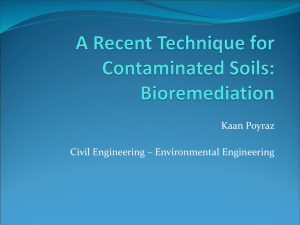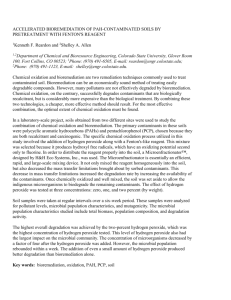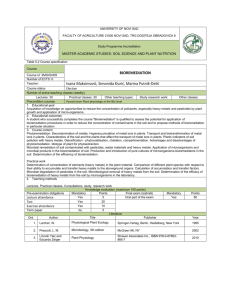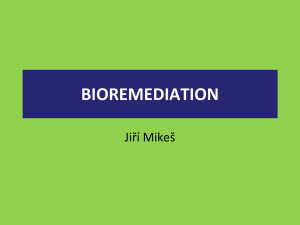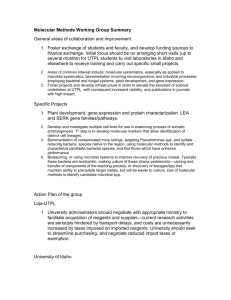Bioremediation
advertisement
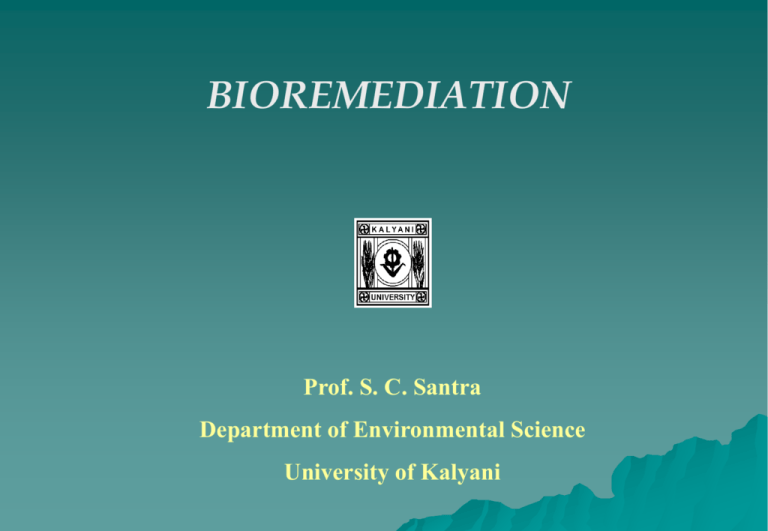
BIOREMEDIATION Prof. S. C. Santra Department of Environmental Science University of Kalyani Definition as per EPA Bioremediation is defined as the process whereby organic wastes are biologically degraded under controlled conditions to an innocuous state, or to levels below concentration limits established by regulatory authorities. It uses naturally occurring microorganisms like bacteria and fungi or plants to degrade or detoxify substances hazardous to human health and/or the environment. - Concept Bioremediation – Concept (Contd..) Recent studies in molecular biology and ecology offer opportunities for more efficient biological processes to clean-up of polluted water and land areas Bioremediation allows natural processes to clean up harmful chemicals in the environment. Microscopic “bugs” or microbes that live in soil and groundwater like to eat certain harmful chemicals. When microbes completely digest these chemicals, they change them into water and harmless gases such as carbon dioxide. Schematic Bioremediation is an option that offers the possibility to destroy or render harmless various contaminants using natural biological activity. Bacteria Actinomycetes Fungi Actinomycetes Fungi Actinomycetes Bioremediation - Basic facts The microorganisms may be indigenous to a contaminated area or they may be isolated from elsewhere and brought to the contaminated site Contaminant compounds are transformed by living organisms through reactions that take place as a part of their metabolic processes. Biodegradation of a compound is often a result of the actions of multiple organisms. Microorganisms must enzymatically attack the pollutants Bioremediation can be effective only where environmental conditions permit microbial growth and activity Manipulation of environmental parameters needed for microbial growth and degradation to proceed at a faster rate. FACTORS OF BIOREMEDIATION The control and optimization of bioremediation processes is a complex system of many factors. existence of a microbial population availability of contaminants to the microbial population the environment factors (type of soil, temperature, pH, the presence of oxygen or other electron acceptors, and nutrients). MICROBIAL POPULATIONS Microorganisms can be isolated from almost any environmental conditions. Microbes will adapt and grow at subzero temperatures, as well as extreme heat, desert conditions, in water, with an excess of oxygen, and in anaerobic conditions, with the presence of hazardous compounds or on any waste stream. The main requirements are an energy source and a carbon source. Because of the adaptability of microbes and other biological systems, these can be used to degrade or remediate environmental hazards. Types of microorganisms Aerobic. Grows in presence of oxygen, degrade pesticides and hydrocarbons, both alkanes and polyaromatic compounds. Many of these bacteria use the contaminant as the sole source of carbon and energy. Examples Pseudomonas, Alcaligenes, Sphingomonas, Rhodococcus, and Mycobacterium. Anaerobic. Grows in absence of oxygen. are not as frequently as aerobic, degrade polychlorinated biphenyls (PCBs), dechlorination of the solvent trichloroethylene (TCE), and chloroform. Methylotrophs. Aerobic bacteria that grow utilizing methane for carbon and energy. The initial enzyme in the pathway for aerobic degradation, methane monooxygenase, has a broad substrate range and is active against a wide range of compounds, including the chlorinated aliphatics trichloroethylene and 1,2dichloroethane. Biostimulation Although the microorganisms are present in contaminated soil, they cannot necessarily be there in the numbers required for bioremediation of the site. Their growth and activity must be stimulated. Biostimulation usually involves the addition of nutrients and oxygen to help indigenous microorganisms. These nutrients are the basic building blocks of life and allow microbes to create the necessary enzymes to break down the contaminants. All of them will need nitrogen, phosphorous, and carbon. Carbon is the most basic element of living forms and is needed in greater quantities than other elements. In addition to hydrogen, oxygen, and nitrogen it constitutes about 95% of the weight of cells. Phosphorous and sulfur contribute with 70% of the remainders. The nutritional requirement of carbon to nitrogen ratio is 10:1, and carbon to phosphorous is 30:1. Biostimulation (Contd..) For degradation it is necessary that bacteria and the contaminants be in contact. This is not easily achieved, as neither the microbes nor contaminants are uniformly spread in the soil. Some bacteria are mobile and exhibit a chemotactic response, sensing the contaminant and moving toward it. Other microbes such as fungi grow in a filamentous form toward the contaminant. It is possible to enhance the mobilization of the contaminant utilizing some surfactants such as sodium dodecyl sulphate The Science – How Does it Work? Microbial Metabolism refers to all the chemical reactions that happen in a cell or organism. All living processes are based on a complex series of chemical reactions. Anabolism – Building complex molecular structures simpler mol. In anabolism, chemicals taken up by the microorganism are used to build various cell parts. Carbon and nitrogen are the basic chemicals in the proteins, sugars and nucleic acids that make up microbial cells. Microorganisms take up carbon and nitrogen from the soil, water, and air around them. In order to take up nutrients and make them into cell parts, a microorganism needs energy. This is where catabolism comes in. Catabolism – Breaking complex molecules into simpler mol. Catabolism allows microorganisms to gain energy from the chemicals available in the environment. Although most microorganisms are exposed to light and to chemical energy sources, most rely on chemicals for their energy. When chemicals break down, energy is released. Microorganisms use this energy to carry out cellular functions, such as those involved in anabolism. Research Mid Super bug Dr. Ananda Mohan Chakraborty Pseudomonas putida. Kinds of Bioremediation Different kinds of bioremediation technologies are currently being used for soil treatment and many more innovative approaches involving bioremediation are being developed. considering the similarity in their cross-media transfer potential, listed below are a few examples of bioremediation technologies and processes: Natural Attenuation Aerobic/Anaerobic biodegradation Biopiles Land Treatment Bioscrubbers Methanotrophic Process (in Situ) Plant Root Uptake (Phytoremediation) Solid Phase Bioremediation Bio Wall for Plume Decontamination (In Situ) Biodegradation Composting Bioreactors Dehalogenation Binding of Metals Fungi Inoculation Process Slurry Phase bioremediation Bioventing (Chapter 7: BMPs for Vapor (Extraction) Bioremediation of Metals (Changing the Valence) Key Features of Bioremediation Most bioremediation treatment technologies destroy the contaminants in the soil matrix. These treatment technologies are generally designed to reduce toxicity either by destruction or by transforming toxic organic compounds into less toxic compounds. Indigenous micro-organisms, including bacteria and fungi, are most commonly used. In some cases, wastes may be inoculated with specific bacteria or fungi known to biodegrade the contaminants in question. Plants may also be used to enhance biodegradation and stabilize the soil. The addition of nutrients or electron acceptors (such as hydrogen peroxide or ozone) to enhance growth and reproduction of indigenous organisms may be required. Field application of bioremediation may involve: – Excavation – Soil handling – Storage of contaminated soil piles – Mixing of contaminated soils – Aeration of contaminated soils – Injection of fluid – Extraction of fluid – Introduction of nutrients and substrates Bioremediation - technology description Bioremediation involves the use of micro-organisms to chemically degrade organic contaminants. Aerobic processes use organisms that require oxygen to be able to degrade contaminants. In come cases, additional nutrients such as nitrogen and phosphorous are also needed to encourage the growth of biodegrading organisms. A biomass of organisms – which may include entrained constituents of the waste, partially degraded constituents, and intermediate biodegradation products – is formed during the treatment process (USEPA, 1990d29) Although bioremediation is applied in many different ways, the description of typical solid phase bioremediation, composting, bioventing, and traditional in situ biodegradation is provided here, besides the description of a few common bioremediation technologies. Solid Phase Bioremediation The solid phase bioremediation treatment can be conducted n lined land treatment units or in composting piles. A lined land treatment unit consists of a prepared bed reactor with a leachate collection system and irrigation and nutrient delivery systems,. The unit may also contain air emission control equipment. The soil is placed on land lined with an impervious layer, such as soil, clay, or a synthetic liner. Bioventing Bioventing uses relatively low-flow soil aeration techniques to enhance the biodegradation of soils contaminated with organic contaminants. Although bioventing is predominantly used to treat unsaturated soils, applications involving the remediation of saturated soils and groundwater (augmented by air sparging) are becoming more common . Generally, a vacuum extraction, an air injection, or a combination of both systems is employed. An air pump, one or more air injections or vacuum extraction probes, and emissions monitors at the ground surface level are commonly used. A basic bioventing system includes a well and a blower, which pumps air through the well and into the soil. Landfarming Ex situ processes also include landfarming, which involves spreading contaminated soils over a large area. Bioremediation may also be conducted in a bioreactor, in which the contaminated soil or sludge is slurried with water in a mixing tank or a lagoon. Bioremediation systems require that the contaminated soil or sludge be sufficiently and homogeneously mixed to ensure optimum contact with the seed organisms. Biopile treatment It is a full-scale technology in which excavated soils are mixed with soil amendments, placed on a treatment area, and bioremediated using forced aeration. It is a hybrid of landfarming and composting. The basic biopile system includes a treatment bed, an aeration system, an irrigation/nutrient system and a leachate collection system. Bioreactors Bioreactors function in a manner that is similar to sewage treatment plants. There are many ways in which a bioreactor can be designed; but most are a modification of one of two systems. In the first system, which is often referred to as a trickling filter or fixed media system. The second common bioreactor design uses a sealed vessel to mix the contaminants, amendments and micro-organisms. Recent research has expanded the capabilities of this technology, which along with its generally lower cost, has led to bioremediation becoming an increasingly attractive cleanup technology. Composting It is a technique that involves combining contaminated soil with nonhazardous organic amendants such as manure or agricultural wastes. The presence of these organic materials supports the development of a rich microbial population and elevated temperature characteristic of composting. Composition of a microbial cell (%). Carbon 50 Nitrogen 14 Oxygen 20 Hydrogen 8 Phosphorous 3 Sulfur 1 Potassium 1 Sodium 1 Calcium 0.5 Magnesium 0.5 Chloride 0.5 Iron 0.2 All others 0.3 Biotreatment of metal and radionuclide: There are many metal tolerant microbes which are capable of accumulating and transforming toxic metals and thus helps in detoxification processes. A number of processes involved in metal removal by different tolerant microorganisms. These includes – Precipitation of heavy metals and radionuclides by production of extra cellular materials which interact with metal cations forming insoluble precipitate; Biotransformation of metals and radio nuclides either by oxidation, reduction or alkylation reactions; Intercellular accumulation or extra cellular accumulation The major mechanisms for bacterial metal precipitation is through the formation of hydrogen sulphide and the immobilization of the metal cations as metal sulphides. Aerobic bacteria like Citrobactor sp produces metal sediment as phosphate salt through phosphatase reactions, where hudrogen phosphate is formed from organic phosphates, such hydrogen phosphate (HPO4=) subsequently precipitates metals and radionuclides (such as lead, cadmium and uranium). The sulphur reducing bacteria viz. Desulfovibrio and Desulfotomaculam produce metal sediment in anaerobic environment In contrary several microorganisms transforms metals and radionuclides by oxidation, reduction or alkalanation reactions. Ferrous (Fe2+) and manganous (Mn2+) compounds can be deposited through oxidation reactions catalysed by species of bacteria, fungi, algae and protozoa. For example Leptothrix is very common ferromanganese oxidizing bacteria produces Fe(OH)3 and MnO2 within a surface bound exopolymer. Similarly Thiobacillus ferrooxidans and Leptospirillum ferrooxidans can solubilize metal from minerals allowing the extraction and recovery of metals such as Cu, Cd, Gold and uranium from low grade ores. All these are oxidative reactions. On the other hand several microbes help in reduction of metal likes mercury, iron, manganese, selenium, arsenic and thus reduces the toxicity of metal ions. Identically tin, selenium and lead can be volatilized by bacteria through the production of alkylated metals. The major bacteria like Pseudomonous and Corynebacterium and fungi like Alterneria alternata perform these reactions in presence of methylating agents Bioaccumulation of metals by microbes are quite well known. Microbes often accumulate metals in intercellular region by active transport or extracellular surface binding. Filamentous fungi like Aspergillus niger and Penicillium species are quite well known for their bioadsorption. A variety of biopolymers like polysaccarides, protein and polyphenolics has proformed metal binding properties. Metal binding proteins such as metallothioneins (cystine rich small peptides) and phytochelations appears to be commonly produced by microbes. In addition in certain categories of microbes metal chelating agents ex siderophores are known. The siderophores are catechol or hydroxamate derivatives. Biodegradation of Aromatics: Several microbes are now well recognized as aromatic degrading organism. Sometime they acts individually or acts together called consortium. A wide variety of bacteria and fungi can carry out aromatic transformation, both partial and complete, under a variety of environmental conditions. The bacteria Pseudomonous putida or fungi like Phanesochaete chrysosporium are well known for arotic compound biotransformation reactions. Under aerobic conditions the most common initial transformation is a hydroxylation that involves the incorporation of molecular oxygen. The enzymes involved in these initial transformations are either monooxygenases or dioxygenases. Fig.1: Incorporation of oxygen into the aromatic ring by the dioxygenase enzyme, followed by meta or ortho ring cleavage Fig.2: Fungal monooxygenase incorporation of oxygen into the aromatic ring coo- acetate CH COOAnaerobic biodegradation 3 Methanogenic bacteria benzoate CH 4 + CO 2 Fig.3: Anaerobic biodegradation of aromatic compounds by a consortium of anaerobic bacteria. Methods of Bioremediation: There are two broad classes of bioremediation1. In-situ bioremediation detoxification – Onsite treatment for 2. Ex-situ bioremediation- Of site treatment toxic materials 3. Sometimes bioremediation takes place by natural ways & means called Intrinsic bioremediation or natural attenuation. Summary of strategies There are many instances where bioremediation technology received better appreciation and viable technology. But there are numbers environmental conditions that influence the bioremediation processes. These include the oxygen availability and nutrient availability for microbial actions in on site treatment areas. Thus bioventing (a technique used to add oxygen directly to a contaminated site through external aeration pipeline or air spraying through forceful injection at contaminated site. The primary nutrient like sources of C, N, P needs to be added in contaminated site for rapid microbial biodegradation process as needed. Surfactant addition has been proposed as a technique for increasing the bioavailability and hence biodegradation of contaminants. The details of various bioremediation techniques are given below: Fig.4: (a) In situ bioremediation in vadose zone and groundwater, (b) Bioventing and biofilteration in vadose zone (c) Bioremediation in the groundwater by air sparging. If appropriate biodegrading microorganisms are not present in soil or if microbial populations have been reduced because of contaminant toxicity, specific microorganisms can be added as “introduced organisms” to enhance the existing populations. This process is known as bioaugmentation. Scientist is now capable of creating ‘super bugs’ organisms that can degrade pollutants at extremely rapid rates. Such organisms can be developed through successive adaptations under condition or can be genetically engineered. laboratory Table: Current Status of Bioremediation (National Research Council, 1993) Future Research Areas in Bioremediation More research needs to be done in order to completely understand the complex microbial processes which make bioremediation possible, especially the bioremediation of metals. Researchers are trying to understand why some microorganisms are better at degrading one kind of chemical than another. The development of better in situ bioremediation strategies are also being studied. In situ treatments would be ideal since they cost less and are less disturbing to the environment. Currently, in situ treatments are problematic because naturally existing external conditions are too difficult to control (dense soil, cold conditions, etc.). Methods for better delivery of nutrients or microorganisms in situ and ex situ are being developed. Advantages of bioremediation Bioremediation is perceived by the public as an acceptable waste treatment process. Microbes able to degrade the contaminant increase in numbers when the contaminant is present; when the contaminant is degraded, the biodegradative population declines. It is safe as the residues for the treatment are usually harmless products and include carbon dioxide, water, and cell biomass. It is useful for the complete destruction of a wide variety of contaminants. This eliminates the chance of future liability associated with treatment and disposal of contaminated material. Instead of transferring contaminants from one environmental medium to another, for example, from land to water or air, the complete destruction of target pollutants is possible. It can often be carried out on site, without disruption of normal activities, no need to transport waste off site. It does not require too much of sophisticated equipments. Bioremediation can prove less expensive than other technologies that are used for clean-up of hazardous waste. Disadvantages of bioremediation Bioremediation is limited to those compounds that are biodegradable. Not all compounds are susceptible to rapid and complete degradation. Biological processes are often highly specific. Important site factors required for success include the presence of metabolically capable microbial populations, suitable environmental growth conditions, and appropriate levels of nutrients and contaminants. It is difficult to extrapolate from bench and pilot-scale studies to full-scale field operations. Research is needed to develop and engineer bioremediation technologies for complex mixtures of contaminants that are not evenly dispersed in the environment. Bioremediation often takes longer than other treatment options, such as excavation and removal of soil or incineration. Limitation of Bioremediation: The problems of on site bioremediation by microbes are often failed for two major reasons. First, the introduced microbe often cannot establish a niche in the environment. In fact, these introduced organisms often do not survive in a new environment beyond a few weeks. Second, there are difficulties in delivering the introduced organisms to the site of contamination, because microorganisms like contaminants, can be strongly sorbed by solid surfaces. An overall scenario in current status of Bioremediation is given in below table. Bioremediation status in India The country has, so far, identified 172 abandoned dump sites located in various states which require remediation. So far, bioremediation in India appears techno economically feasible because of the prevailing tropical climate almost throughout the year in most of the States and Union Territories. Phytoremediation in India is being extensively used for restoration of environmental quality. However, there exists ample scope to modify the process through biostimulation and bioaugmentation as well as through better understanding of the behavior of microbial community. Also, the potential for generation of carbon credit through phytoremediation intervention as well as through solid waste composting (instead of land filling) needs to be identified and applied wherever possible. THANK YOU
